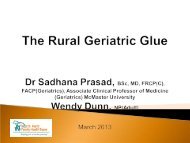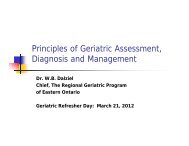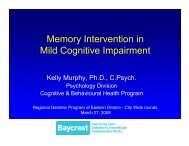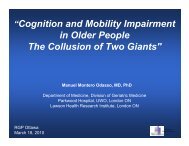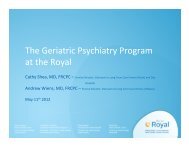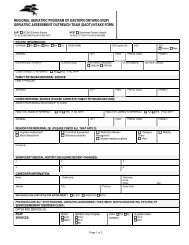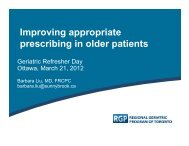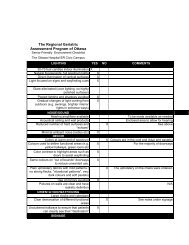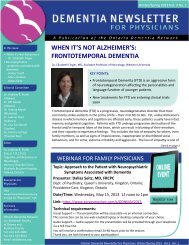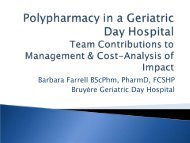MOCA MMSE - Regional Geriatric Program of Eastern Ontario
MOCA MMSE - Regional Geriatric Program of Eastern Ontario
MOCA MMSE - Regional Geriatric Program of Eastern Ontario
You also want an ePaper? Increase the reach of your titles
YUMPU automatically turns print PDFs into web optimized ePapers that Google loves.
THE M AIN EVENT<br />
<strong>MMSE</strong><br />
MoCA<br />
vs.<br />
<strong>Regional</strong> <strong>Geriatric</strong> <strong>Program</strong> <strong>of</strong> <strong>Eastern</strong> <strong>Ontario</strong><br />
City Wide Rounds<br />
Dr. Frank Molnar<br />
April 17, 2009
Objectives<br />
1. To learn how to review validation studies (studies <strong>of</strong><br />
sensitivity and specificity)<br />
2. To use this new knowledge to review validation<br />
studies for the use <strong>of</strong> the <strong>MOCA</strong> in dementia / MCI<br />
3. To discuss the copyright issues <strong>of</strong> the <strong>MMSE</strong> (and<br />
<strong>MOCA</strong>)<br />
4. To discuss the optimal use <strong>of</strong> the <strong>MOCA</strong><br />
• For those with <strong>MMSE</strong> ≥ 26?<br />
• For those in whom the <strong>MMSE</strong> is unrevealing?<br />
• In place <strong>of</strong> the <strong>MMSE</strong>?
Disclosure<br />
• I do not own stocks in nor have I been employed by<br />
any company with a financial interest in either the<br />
<strong>MMSE</strong> or <strong>MOCA</strong>.<br />
• I have formal methodological training (i.e. MSc<br />
Thesis) in the derivation and validation <strong>of</strong> cognitive<br />
tests.<br />
• I use both the <strong>MMSE</strong> and the <strong>MOCA</strong> in clinical<br />
practice<br />
• I am not a copyright lawyer
Acknowledgements<br />
• Ian MacDowell<br />
• Malcolm Hing<br />
• Judy Willoughby<br />
• My patients<br />
• Everyone else who has argued with me about<br />
these concepts
The Preliminary Event<br />
• In order to truly understand the<br />
results <strong>of</strong> the studies to be reviewed<br />
we need to understand:<br />
• The definitions <strong>of</strong> sensitivity and<br />
specificity<br />
• How sensitivity and specificity are<br />
affected by:<br />
• Cut-<strong>of</strong>f values employed<br />
• Overlap <strong>of</strong> cognitive scores<br />
• Choice <strong>of</strong> test
Definitions<br />
Sensitivity<br />
• % <strong>of</strong> diseased persons identified as<br />
diseased (score below cut-<strong>of</strong>f)<br />
Specificity<br />
• % <strong>of</strong> normal persons identified as<br />
normal (score above cut-<strong>of</strong>f)
1. Sensitivity and specificity are<br />
affected by the cut-<strong>of</strong>f score<br />
employed
Scores for persons<br />
with normal<br />
cognition<br />
Specificity = 25%<br />
xxx x x<br />
x x x x x<br />
xx x x x<br />
x x x x x<br />
1) Sensitivity = % with disease<br />
who are identified as diseased by<br />
test (i.e. % <strong>of</strong> diseased that fall<br />
below cut-<strong>of</strong>f score)<br />
2) Specificity = % <strong>of</strong> normals<br />
who are identified as normal by<br />
test (i.e. % <strong>of</strong> normals that<br />
score above cut-<strong>of</strong>f)<br />
<strong>MOCA</strong> or <strong>MMSE</strong><br />
30<br />
20<br />
10<br />
0<br />
xx x x<br />
xx x<br />
xxx x<br />
x<br />
xx xx<br />
xx<br />
xxx x<br />
x x xx<br />
xxx xx<br />
x xx x x<br />
Scores for persons<br />
with dementia<br />
Sensitivity = 100%
Scores for persons<br />
with normal<br />
cognition<br />
Specificity = 50%<br />
xxx x x<br />
x x x x x<br />
xx x x x<br />
x x x x x<br />
1) Sensitivity = % with disease<br />
who are identified as diseased by<br />
test (i.e. % <strong>of</strong> diseased that fall<br />
below cut-<strong>of</strong>f score)<br />
2) Specificity = % <strong>of</strong> normals<br />
who are identified as normal by<br />
test (i.e. % <strong>of</strong> normals that<br />
score above cut-<strong>of</strong>f)<br />
<strong>MOCA</strong> or <strong>MMSE</strong><br />
30<br />
20<br />
10<br />
0<br />
xx x x x<br />
xxxx x<br />
x xxx x<br />
xxxxxx<br />
xx xxx<br />
xxxxx<br />
xxx x<br />
x x xx<br />
x<br />
Scores for persons<br />
with dementia<br />
Sensitivity = 87.5%
Scores for persons<br />
with normal<br />
cognition<br />
Specificity = 75%<br />
xxx x x<br />
x x x x x<br />
xx x x x<br />
x x x x x<br />
1) Sensitivity = % with disease<br />
who are identified as diseased by<br />
test (i.e. % <strong>of</strong> diseased that fall<br />
below cut-<strong>of</strong>f score)<br />
2) Specificity = % <strong>of</strong> normals<br />
who are identified as normal by<br />
test (i.e. % <strong>of</strong> normals that<br />
score above cut-<strong>of</strong>f)<br />
<strong>MOCA</strong> or <strong>MMSE</strong><br />
30<br />
20<br />
10<br />
0<br />
xx x x x<br />
xxxx x<br />
x xxx x<br />
xxxxxx<br />
xx xxx<br />
xxxxx<br />
xxx x<br />
x x xx<br />
x<br />
Scores for persons<br />
with dementia<br />
Sensitivity = 75%
Scores for persons<br />
with normal<br />
cognition<br />
Specificity = 100%<br />
xxx xx x<br />
x x x x x<br />
xx x x x<br />
x x x x x<br />
1) Sensitivity = % with disease<br />
who are identified as diseased by<br />
test (i.e. % <strong>of</strong> diseased that fall<br />
below cut-<strong>of</strong>f score)<br />
2) Specificity = % <strong>of</strong> normals<br />
who are identified as normal by<br />
test (i.e. % <strong>of</strong> normals that<br />
score above cut-<strong>of</strong>f)<br />
<strong>MOCA</strong> or <strong>MMSE</strong><br />
30<br />
20<br />
10<br />
0<br />
xx x x x<br />
xxxx x<br />
x xxx x<br />
xxxxxx<br />
xx xxx<br />
xxxxx<br />
xxx x<br />
x x xx<br />
x<br />
Scores for persons<br />
with dementia<br />
Sensitivity = 62.5%
Scores for persons<br />
with normal<br />
cognition<br />
Specificity = 100%<br />
xxx xx x<br />
x x x x x<br />
xx x x x<br />
x x x x x<br />
1) Sensitivity = % with disease<br />
who are identified as diseased by<br />
test (i.e. % <strong>of</strong> diseased that fall<br />
below cut-<strong>of</strong>f score)<br />
2) Specificity = % <strong>of</strong> normals<br />
who are identified as normal by<br />
test (i.e. % <strong>of</strong> normals that<br />
score above cut-<strong>of</strong>f)<br />
<strong>MOCA</strong> or <strong>MMSE</strong><br />
30<br />
20<br />
10<br />
0<br />
xx x x x<br />
xxxx x<br />
x xxx x<br />
xxxxxx<br />
xx xxx<br />
xxxxx<br />
xxx x<br />
x x xx<br />
x<br />
Scores for persons<br />
with dementia<br />
Sensitivity = 35%
Take Home Message #1<br />
Sensitivity and Specificity for any given<br />
test are dependent on cut-<strong>of</strong>f score<br />
studied<br />
For scales where high scores are good and<br />
low scores are bad (<strong>MMSE</strong>, <strong>MOCA</strong>)<br />
• When cut-<strong>of</strong>f is lowered<br />
• Sensitivity decreases<br />
• Specificity increases<br />
• When cut-<strong>of</strong>f is raise<br />
• Sensitivity increase<br />
• Specificity decreases
Sensitivity vs. Specificity<br />
100<br />
90<br />
80<br />
70<br />
60<br />
50<br />
40<br />
30<br />
20<br />
10<br />
0<br />
10 20 30<br />
<strong>MMSE</strong> and MoCA<br />
specificity<br />
sensitivity
2. Sensitivity and specificity are<br />
affected by the population in<br />
which the test is being used<br />
- Overlap <strong>of</strong> cognitive scores<br />
(spectrum <strong>of</strong> disease)
Scores for persons<br />
with normal<br />
cognition<br />
Specificity = 75%<br />
xxx x x<br />
x x x x x<br />
xx x x x<br />
x x x x x<br />
1) Sensitivity = % with disease<br />
who are identified as diseased by<br />
test (i.e. % <strong>of</strong> diseased that fall<br />
below cut-<strong>of</strong>f score)<br />
2) Specificity = % <strong>of</strong> normals<br />
who are identified as normal by<br />
test (i.e. % <strong>of</strong> normals that<br />
score above cut-<strong>of</strong>f)<br />
<strong>MOCA</strong> or <strong>MMSE</strong><br />
30<br />
20<br />
10<br />
0<br />
xx x x x<br />
xxxx x<br />
x xxx x<br />
xxxxxx<br />
xx xxx<br />
xxxxx<br />
xxx x<br />
x x xx<br />
x<br />
Scores for persons<br />
with dementia<br />
Sensitivity = 62%
Scores for persons<br />
with normal<br />
cognition<br />
Specificity = 75%<br />
xxx x x<br />
x x x x x<br />
xx x x x<br />
x x x x x<br />
1) Sensitivity = % with disease<br />
who are identified as diseased by<br />
test (i.e. % <strong>of</strong> diseased that fall<br />
below cut-<strong>of</strong>f score)<br />
2) Specificity = % <strong>of</strong> normals<br />
who are identified as normal by<br />
test (i.e. % <strong>of</strong> normals that<br />
score above cut-<strong>of</strong>f)<br />
<strong>MOCA</strong> or <strong>MMSE</strong><br />
30<br />
20<br />
10<br />
0<br />
xx x x x<br />
xxxx x<br />
x xxx x<br />
xxxxxx<br />
xx xxx<br />
xxxxx<br />
xxx x<br />
x x xx<br />
x<br />
Scores for persons<br />
with dementia<br />
Sensitivity = 75%
Scores for persons<br />
with normal<br />
cognition<br />
Specificity = 75%<br />
xxx x x<br />
x x x x x<br />
xx x x x<br />
x x x x x<br />
1) Sensitivity = % with disease<br />
who are identified as diseased by<br />
test (i.e. % <strong>of</strong> diseased that fall<br />
below cut-<strong>of</strong>f score)<br />
2) Specificity = % <strong>of</strong> normals<br />
who are identified as normal by<br />
test (i.e. % <strong>of</strong> normals that<br />
score above cut-<strong>of</strong>f)<br />
<strong>MOCA</strong> or <strong>MMSE</strong><br />
30<br />
20<br />
10<br />
0<br />
xx x x x<br />
xxxx x<br />
x xxx x<br />
xxxxxx<br />
xx xxx<br />
xxxxx<br />
xxx x<br />
x x xx<br />
x<br />
Scores for persons<br />
with dementia<br />
Sensitivity = 87.5%
Scores for persons<br />
with normal<br />
cognition<br />
Specificity = 75%<br />
xxx x x<br />
x x x x x<br />
xx x x x<br />
x x x x x<br />
1) Sensitivity = % with disease<br />
who are identified as diseased by<br />
test (i.e. % <strong>of</strong> diseased that fall<br />
below cut-<strong>of</strong>f score)<br />
2) Specificity = % <strong>of</strong> normals<br />
who are identified as normal by<br />
test (i.e. % <strong>of</strong> normals that<br />
score above cut-<strong>of</strong>f)<br />
<strong>MOCA</strong> or <strong>MMSE</strong><br />
30<br />
20<br />
10<br />
0<br />
xx x x x<br />
xxxx x<br />
x xxx x<br />
xxxxxx<br />
xx xxx<br />
xxxxx<br />
xxx x<br />
x x xx<br />
x<br />
Scores for persons<br />
with dementia<br />
Sensitivity = 100%
Scores for persons<br />
with normal<br />
cognition<br />
Specificity = 100%<br />
1) Sensitivity = % with disease<br />
who are identified as diseased by<br />
test (i.e. % <strong>of</strong> diseased that fall<br />
below cut-<strong>of</strong>f score)<br />
2) Specificity = % <strong>of</strong> normals<br />
who are identified as normal by<br />
test (i.e. % <strong>of</strong> normals that<br />
score above cut-<strong>of</strong>f)<br />
<strong>MOCA</strong> or <strong>MMSE</strong><br />
xxxx x x x<br />
x x x xxx x<br />
xx x xxx<br />
30<br />
20<br />
10<br />
0<br />
xx x x x<br />
xxxx x<br />
x xxx x<br />
xxxxxx<br />
xx xxx<br />
xxxxx<br />
xxx x<br />
x x xx<br />
x<br />
Scores for persons<br />
with dementia<br />
Sensitivity = 100%
Less overlap – higher combined<br />
sensitivity and specificity<br />
0 10 20 30<br />
Greater overlap – lower combined<br />
sensitivity and specificity<br />
0 10 20 30
Correct population distribution<br />
0 10 20 30<br />
Incorrect distribution resulting in exaggerated<br />
sensitivity and specificity<br />
0 10 20 30
Take Home Message #2<br />
The sensitivity and specificity depend on the<br />
amount <strong>of</strong> test score overlap between<br />
normal and diseased<br />
• Sensitivity and specificity depend on<br />
sample / population<br />
Since the populations we take care <strong>of</strong><br />
clinically are different from those in studies<br />
• The Sensitivity and Specificity <strong>of</strong> a test in<br />
clinical practice will likely not match that in<br />
studies (we cannot know if it does)<br />
• We can still compare the tests within 1 study
3 Take Home Messages<br />
1. Sensitivity and Specificity for any given<br />
test are dependent on cut-<strong>of</strong>f score<br />
2. Sensitivity and Specificity depend on<br />
sample / population<br />
<br />
Since the populations we take care <strong>of</strong><br />
clinically are different from those in studies<br />
the Sensitivity and Specificity <strong>of</strong> a test in<br />
clinical practice will likely not match that in<br />
studies<br />
3. Sensitivity and Specificity are dependent<br />
on the test employed
3. Sensitivity and specificity<br />
are affected by the test<br />
employed
THE MAIN EVENT<br />
MoCA<br />
In this<br />
corner…<br />
<strong>MMSE</strong>
<strong>MOCA</strong> validation process<br />
• Developed based on clinical intuition <strong>of</strong> main author<br />
(ZN)<br />
• Iterative modification based on 5 years <strong>of</strong> clinical use<br />
• Tested on 46 MCI / AD with <strong>MMSE</strong> > 24 vs. 46<br />
normal<br />
• 5 items replaced & weighting adjusted<br />
• Clinical distribution<br />
• We are now in the stage <strong>of</strong> validation<br />
• Ongoing process<br />
• Main dementia / MCI articles to be<br />
reviewed.
Search Strategy<br />
• Emailed the author <strong>of</strong> the first article<br />
(Ziad Nasreddine)<br />
• MoCA validation studies kept up-to-date on<br />
MoCA's website reference section at<br />
www.mocatest.org<br />
• RGPEO Librarian searched the literature<br />
• Did not find any studies not found on above<br />
website
3 <strong>MOCA</strong> Validation Studies in area <strong>of</strong> Dementia<br />
1. Nasreddine et al. The Montreal Cognitive<br />
Assessment, <strong>MOCA</strong>: A brief Screening Tool For<br />
Mild Cognitive Impairment. Journal <strong>of</strong> the American<br />
<strong>Geriatric</strong>s Society 2005; 53: 695-699<br />
2. Smith et al. The Montreal Cognitive Assessment:<br />
validity and Utility in a Memory Clinic Setting. The<br />
Canadian Journal <strong>of</strong> psychiatry 2007; 52; 329-332<br />
3. Luis et al. Cross validation <strong>of</strong> the Montreal Cognitive<br />
Assessment in community dwelling older adults<br />
residing in the Southern US. International Journal <strong>of</strong><br />
<strong>Geriatric</strong> Psychiatry 2008
Nasreddine et al - Design<br />
• 94 MCI & 93 AD (90 <strong>MMSE</strong> ≥17),90 NC<br />
at 2 Quebec MDCs<br />
• Clinical diagnoses<br />
• MCI – portions <strong>of</strong> Wechsler Memory Scale<br />
• French and English <strong>MMSE</strong>s / <strong>MOCA</strong>s<br />
• Note; language-based (verbal) tests must<br />
be separately validated in each language<br />
• I am not certain this was done
Nasreddine et al - Results<br />
• <strong>MOCA</strong> (cut-<strong>of</strong>f 25/26)<br />
• 90% SENS to detect MCI<br />
• 100% SENS to detect AD<br />
• <strong>MMSE</strong> (cut-<strong>of</strong>f 25/26)<br />
• 18% SENS to detect MCI<br />
• 78% SENS to detect AD<br />
• <strong>MOCA</strong> seems to win on SENS<br />
(particularly for MCI)
Nasreddine et al - Results<br />
• SPEC = % Normals ≥ 26 (correctly<br />
identified as normal<br />
• <strong>MOCA</strong> (cut-<strong>of</strong>f 25/26)<br />
• 87% SPEC to normals<br />
• Mislabelled 13% as impaired<br />
• <strong>MMSE</strong> (cut-<strong>of</strong>f 25/26)<br />
• 100% SPEC to normals<br />
• <strong>MMSE</strong> seems to win on SPECS
Nasreddine – Results (my interpretation)<br />
• The results only describe part <strong>of</strong><br />
the story<br />
• If you lowered the <strong>MOCA</strong> cut-<strong>of</strong>f, its specificity<br />
would improve and sensitivity will drop<br />
• If you raise the <strong>MMSE</strong> cut-<strong>of</strong>f, its sensitivity would<br />
improve and specificity will drop<br />
• SENS / SPEC are very dependent on cut<strong>of</strong>fs.<br />
• In any case, we do not rely solely on<br />
cut-<strong>of</strong>f scores but look at which parts <strong>of</strong><br />
the test were failed (disaggregate<br />
analysis)
Nasreddine et al – recommendations<br />
• If patients have cognitive complaints<br />
and functional impairment then likely<br />
dementia<br />
• <strong>MMSE</strong> first<br />
• <strong>MOCA</strong> if <strong>MMSE</strong> ≥ 26 (MCI, Mild dementia)<br />
• If patients have cognitive complaints<br />
but no functional impairment then likely<br />
normal or MCI<br />
• <strong>MOCA</strong> first
Smith et al.- Design<br />
◦ 6 month prospective study <strong>of</strong> 67 patients<br />
with <strong>MMSE</strong> > 24 at UK MDC (mean <strong>MMSE</strong><br />
27.4). I will only look at initial<br />
assessment – not 6 month F/U<br />
• 32 dementia (ICD-10)<br />
◦ 18 AD, 13 VaD, 1 PDD<br />
• 23 MCI (Petersen Criteria)<br />
• 12 MCC (normal memory or clearly identifiable<br />
psychiatric disease causing subjective memory<br />
complaint)
Smith et al.- Results (Table 2)<br />
◦ <strong>MOCA</strong> (cut-<strong>of</strong>f 25/26)<br />
• 83% SENS to detect MCI<br />
• 94% SENS to detect Dementia<br />
◦ <strong>MMSE</strong> (cut-<strong>of</strong>f 25/26)<br />
• 17% SENS to detect MCI<br />
• 25% SENS to detect Dementia<br />
◦ <strong>MOCA</strong> seems to win on SENS (for<br />
both MCI and Dementia) using<br />
25/26 cut-<strong>of</strong>fs
Smith et al.- Results (Table 2)<br />
◦ SPEC = % MCC ≥ 26 (correctly<br />
identified as not MCI / Dementia)<br />
◦ <strong>MOCA</strong> (cut-<strong>of</strong>f 25/26)<br />
• 50% SPEC to MCC<br />
◦ Mislabelled 50% as MCI / Dementia<br />
◦ <strong>MMSE</strong> (cut-<strong>of</strong>f 25/26)<br />
• 100% SPEC to MCC<br />
◦ <strong>MMSE</strong> seems to win on SPEC at<br />
25/26 cut-<strong>of</strong>fs
Smith et al.- Results (my interpretation)<br />
◦ The results only describe part <strong>of</strong><br />
the story<br />
• If you lowered the <strong>MOCA</strong> cut-<strong>of</strong>f, its specificity<br />
would improve and sensitivity will drop<br />
• If you raise the <strong>MMSE</strong> cut-<strong>of</strong>f, its sensitivity<br />
would improve and specificity will drop<br />
• SENS / SPEC are very dependent on cut<strong>of</strong>fs.<br />
◦ In any case, we do not rely solely<br />
on cut-<strong>of</strong>f scores but look at which<br />
parts <strong>of</strong> the test were failed<br />
(disaggregate analysis)
Smith et al.- Conclusions<br />
◦ Findings support conclusions <strong>of</strong><br />
Nasreddine et al<br />
◦ Low specificity <strong>of</strong> <strong>MOCA</strong> may be<br />
because used MCC rather than<br />
normal controls<br />
◦ <strong>MOCA</strong> is a useful screen in a<br />
memory disorder clinic for people<br />
who score > 25 on the <strong>MMSE</strong>
Luis et al - design<br />
• 118 community-dwelling (Florida)<br />
subjects involved in a prospective study<br />
• 20 probable AD (NINCDS-ADRDA)<br />
• 24 amnestic MCI (Petersen)<br />
• 74 cognitively normal<br />
• looked at sensitivity vs. specificity over a<br />
range <strong>of</strong> cut-<strong>of</strong>fs. This represents a<br />
major improvement in analytic<br />
methodology over the 2 previous studies.
Luis et al – Results (Table 2)<br />
• <strong>MOCA</strong> (cut-<strong>of</strong>f 26/27 – higher than prior studies)<br />
• 100% SENS & 35% SPEC to detect MCI<br />
• 97% SENS & 35% SPEC to detect MCI/AD<br />
• <strong>MOCA</strong> (cut-<strong>of</strong>f 23/24 – lower than prior studies)<br />
• 96% SENS & 95% SPEC to detect MCI<br />
• This is a suspect finding:<br />
• too good – never see these values in cognitive tests<br />
• see next slide<br />
• <strong>MMSE</strong> (cut-<strong>of</strong>f 27/28 – higher than prior studies)<br />
• 58% SENS & 84% SPEC to detect MCI<br />
• <strong>MMSE</strong> (cut-<strong>of</strong>f 24/25 – lower than prior studies)<br />
• 17% SENS & 96% SPEC to detect MCI<br />
• 36% SENS & 96% SPEC to detect MCI/AD
Sensitivity vs. Specificity<br />
100<br />
90<br />
80<br />
70<br />
60<br />
50<br />
40<br />
30<br />
20<br />
10<br />
0<br />
10 20 30<br />
<strong>MMSE</strong> and MoCA<br />
specificity<br />
sensitivity
Possible explanation<br />
Incorrect distribution resulting in exaggerated<br />
sensitivity and specificity
Luis et al – My Conclusions<br />
• The results are questionable - likely due<br />
to patient selection factors<br />
• The sample size (20 AD) was likely too small<br />
resulting in a non-representative sample with<br />
spectrum bias<br />
• I believe the results indicate that 96% <strong>of</strong> MCI<br />
participants had a <strong>MOCA</strong> ≤ 23. Does this make<br />
sense clinically or do you see MCI patients with<br />
<strong>MOCA</strong> ≥ 24?<br />
• The analytic approach (examining ROC curves to find the best<br />
cut-<strong>of</strong>fs) should be the standard – I used this approach for my<br />
MSc thesis in the 1990s and it was standard back then.
MY SUMMARY <strong>of</strong> <strong>MOCA</strong><br />
studies<br />
• First 2 validation studies did not employ best methodology<br />
• 3 rd validation study likely has spectrum bias.<br />
• In all tests, when sensitivity increases, specificity decreases (the<br />
reverse is also true). This trade-<strong>of</strong>f <strong>of</strong> sensitivity vs. specificity<br />
means that the increased sensitivity <strong>of</strong> the <strong>MOCA</strong> comes<br />
with the expected price – lower specificity resulting in more<br />
normal people being labelled as impaired (higher false<br />
positives).<br />
• At a cut-<strong>of</strong>f <strong>of</strong> 25/26 <strong>MOCA</strong> better at picking up AD than <strong>MMSE</strong><br />
(with cut-<strong>of</strong>f <strong>of</strong> 25/26)<br />
– This may not be true if <strong>MMSE</strong> cut-<strong>of</strong>fs are altered<br />
Despite the limitations with these studies, I believe the<br />
<strong>MOCA</strong> better than <strong>MMSE</strong> at detecting MCI / early<br />
dementia<br />
– Likely a ceiling effect <strong>of</strong> the <strong>MMSE</strong> that increasing cut-<strong>of</strong>f will<br />
probably not compensate for.
Tests may have differential sensitivity in<br />
different ranges <strong>of</strong> cognitive decline<br />
MCI<br />
Normal<br />
<strong>MOCA</strong><br />
30<br />
25<br />
20<br />
<strong>MMSE</strong><br />
30<br />
Moderate dementia<br />
Severe dementia<br />
Mild dementia<br />
15<br />
10<br />
5<br />
25<br />
20<br />
15<br />
10<br />
5<br />
0 0
NOW FOR SOMETHING<br />
COMPLETELY DIFFERENT<br />
• That was the science<br />
• Now we move to the social /<br />
legal environment in which the<br />
<strong>MMSE</strong> and <strong>MOCA</strong> operate
http://www3.parinc.com/uploads/pdfs/<strong>MMSE</strong>_Copyright_PermReq.pdf<br />
<strong>MMSE</strong> Copyright Permission Request Form<br />
Permission is necessary if you want to use a modified version <strong>of</strong> the <strong>MMSE</strong>, including a modified format or<br />
translation. If you plan to use the <strong>MMSE</strong> in its entirety and in its published form, you must purchase the<br />
number <strong>of</strong> test protocols you will need for your purposes. To purchase the published form please<br />
contact PAR Customer Support at 1.800.331.8378, or if outside the US and Canada at 813.968.3003.<br />
• PAR will not grant permission to include the entire <strong>MMSE</strong> Test Form or scale in any publication, including<br />
dissertations and theses. However, inclusion <strong>of</strong> up to four sample items may be approved.<br />
• A per-copy royalty fee will be charged for all permissions granted for copies <strong>of</strong> translations <strong>of</strong> the <strong>MMSE</strong> or<br />
modified versions <strong>of</strong> the test form. This fee does not include the cost <strong>of</strong> the User’s Guide, which is<br />
necessary if you plan to obtain permission to use a translation or modified version <strong>of</strong> the test form.<br />
There will be a permission fee charged for reproduction <strong>of</strong> up to four sample items from the <strong>MMSE</strong> Test Form to<br />
be included in publications.<br />
• Payment can be made in U.S. funds via check, money order, VISA, MasterCard, American Express, or<br />
Discover. We also accept <strong>of</strong>ficial institutional purchase orders from U.S. and Canadian residents.<br />
Please complete the remainder <strong>of</strong> this form. Required sections are noted and highlighted. Please complete all<br />
sections that are relevant to your request. If all <strong>of</strong> the required sections are not completed, we will not be<br />
able to process your request. Once the form is completed, please send the form to the address below:<br />
Copyright Permissions Department<br />
16204 North Florida Avenue, Lutz, Florida 33549<br />
Fax: Toll free 1.800.727.9329 (US & Canada). All other locations, fax 813.968.2598<br />
E-mail: copyright@parinc.com<br />
Upon submission <strong>of</strong> a completed form, your request will be reviewed and we will contact you
Is this copyright valid?<br />
• Can one copyright something that has been<br />
in the public domain for decades?<br />
• Similar to ‘established right <strong>of</strong> way argument’<br />
• Can one copyright something that has<br />
appeared in numerous publications?<br />
• Each publication holds copyright on its content
Does this copyright effect us (will it be<br />
enforced if found to be valid)?<br />
• Clinically?<br />
• Are we individuals or a program / institution?<br />
• Research?<br />
• Can one publish research that involves the<br />
<strong>MMSE</strong>?<br />
• Will they go after ‘little fish’ like us?<br />
• Is it worth the cost <strong>of</strong> litigation for our relatively<br />
small scale use?<br />
• Who wants to be the test case?
<strong>MOCA</strong> – also copyrighted<br />
• Copyright not enforced (no demands for<br />
payment).<br />
• Will this be permanent?<br />
• Note the concept <strong>of</strong> ‘stealth copyrighting’<br />
• Allow a product to gain widespread use before<br />
enforcing copyright as occurred with the <strong>MMSE</strong><br />
• Is any cognitive test immune from this process<br />
in the future?
COST:<br />
How to read studies & select tests:<br />
Cut-<strong>of</strong>f:<br />
Sensitivity and Specificity for any given test are dependent on cut-<strong>of</strong>f score<br />
Objective:<br />
- screen for MCI & dementia in community (high cut-<strong>of</strong>f)<br />
- screen for dementia (not MCI) in community (lower cut-<strong>of</strong>f)<br />
- NOT for diagnosis<br />
- on inpatient setting can only screen for cognitive impairment (delirium,<br />
depression, MCI, dementia)<br />
Sample:<br />
Sensitivity and Specificity depend on sample / population. Since the<br />
populations we take care <strong>of</strong> clinically are different from those in studies the<br />
Sensitivity and Specificity <strong>of</strong> a test in clinical practice will likely not match that<br />
in studies<br />
Test Characteristics:<br />
Sensitivity and Specificity are dependent on the test employed. <strong>MOCA</strong> has<br />
high sensitivity but low specificity (relative to <strong>MMSE</strong>)
Given all <strong>of</strong> the above - How<br />
do I suggest using the <strong>MOCA</strong>?<br />
• If it was used before to compare measures<br />
• If seeing someone who is high functioning and likely in the normal /<br />
MCI / very early dementia range<br />
• No / few/ borderline functional problems<br />
• If <strong>MMSE</strong> > 26<br />
• If <strong>MMSE</strong> results are unrevealing<br />
• If history suggests a need for a better measure <strong>of</strong> attention / frontal<br />
executive function (e.g. Lewy Body Disease, Frontal Lobe dementia)<br />
and language than <strong>MMSE</strong> provides<br />
• Look at areas where points were lost and decide how important this is.<br />
• If using in research or for large numbers <strong>of</strong> people I would consider the<br />
<strong>MOCA</strong> given the <strong>MMSE</strong> enforced copyright (or would consider paying<br />
to use the <strong>MMSE</strong>)




